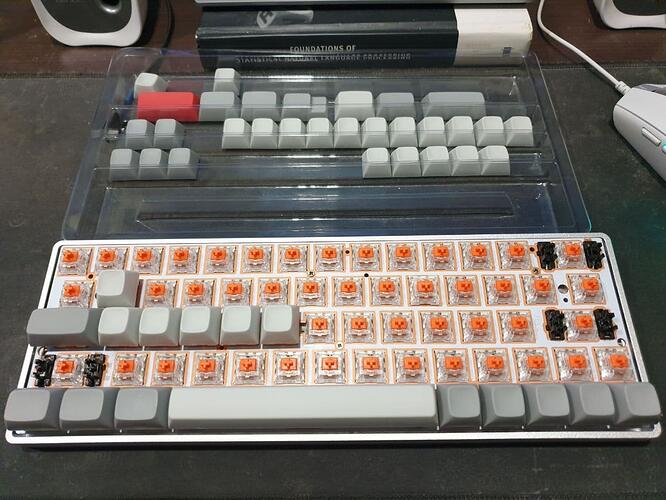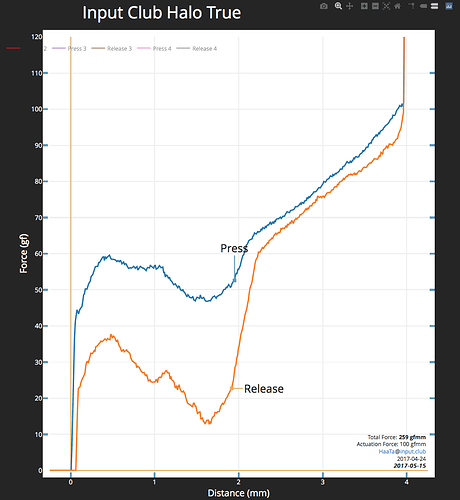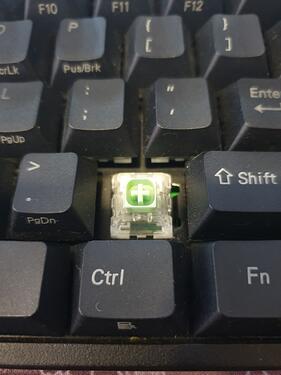Same. The V2s are better but they are still not quite there. I’ve considered buying a steel keycap just to use it as a stem-shaver. I know someone went through the trouble of developing a specialized tool for this purpose called the Cruciformer, but I don’t think anyone sells them right now.
there are non box versions of the click kailh switches, that are better IMO. I just dislike the box design in general tho.
I regret not stocking up on 5 pin speed bronzes years ago
Reviving this thread once again with the announcement of Clickiez 
The general sentiment seems like one of cautious optimism
While I’m waiting for my Greenios I mean Clickiez, I’ve been messing around with the non-BOX Kailh click-bar switches, and I quite like them.
Well. IDK about Sherbets. It was a neat idea but linear pre-travel before a click-bar isn’t my bag. Anyway - I really would like to see 5-pin versions of the Speed Navies and Speed Bronzes readily available like the BOXes do with the Crystal line. I’d also like to see Kailh give the speed-bar line some more love - there are a bazillion BOX clickies but what, three whole non-BOX click-bar switches?
Looking for something with a bit more tactility than the Speed Bronze and a little bit less weight than the Speed Navies, I took the stem and spring from the former and placed it in the housing of the latter. IMO they could sell this configuration in a different color and it would do fine as a commercial switch; a nice balance of extra-crispy and use-able. I present to you…
Kailh Speed Gravy
I second this, been waiting for them to release a kailh speed jades, I feel like that would be dope.
I picked up some Sherbets for cheap. It’s a very interesting switch to me! I understand why it’s polarizing – but I very much enjoy using them
If you’re testing an individual unmounted switch, it’s going to feel very weird and rather “off”. The linear pretravel feels needlessly long, and you can actually feel yourself stopping at the clickbar without actuating it. Then, it requires quite a good amount of force to overcome the clickbar which results in an immediate and sharp bottom out. Certainly doesn’t sound like a good time.
But mounting it on a full board and typing away - that’s a completely different story. It feels very good to type with. The linear pretravel gives an illusion of smoothness and the tactile event of overcoming the clickbar is very satisfying. A very sharp/crisp tactile event that gives a confident register of the keystroke. You’ll certainly bottom out after overcoming the clickbar, so the the actuation point feels like it occurs together with the tactile event (even if it might be after the tactile event). The full 4mm of travel makes typing much more enjoyable too – caveated with my dislike of shorter travel.
I’m rather accustomed to heavier switches, so I didn’t find it fatiguing to type with the Sherbets, despite their 83g peak. I think it has to do with the linear pretravel portion. That initial actuation at 45g lulls you into an illusion that the switch is light, and given that you’ve already applied >=45g, the resistance to 70g (bottom out) or 83g (peak) feels progressive. In my experience, it’s monumentally less fatiguing than Box Navy or Box Pale Blue, where the initial actuation is higher, thus requiring more effort for that initial push.
We can’t talk about clicky switches without talking about the sound… and the Sherbets are unapologetically LOUD. Typing quickly or slowly doesn’t mitigate the sound. I suppose that’s due to the force required to overcome the clickbar and how it bottoms out almost immediately after that. That said, I do enjoy the confident, unabashed sounds that the Sherbet produces. It’s not a wimpy or chattering click, but something more akin to the sound of a stapler.
The Sherbets work wonderfully with MT3 keycaps. The Sherbets do have some wobble and you’d feel it with taller MT3 keycaps when testing individually. But for actual typing, the aggressive scoops of MT3 means that you’ll be striking the keys dead center, which reduces any perceived wobble when typing. I’ve yet to try the Sherbets with other keycap profiles. As for MT3, I think they work better with clicky switches rather than linears (again, personal preference).
In summary, I think the Sherbets are a pretty underrated switch! They do make for a uniquely satisfying typing experience. It has to be mounted on a full board for typing, and not just evaluated as a single switch for the experience is vastly different. More so than any other switch I’ve experienced thus far
Because people only tried them in floating switch gamer rubbish keyboards and not in a proper vintage-style chassis where the sound is allowed to reverberate.
Gateron Blue full milk housing is seriously underrated. It’s smoother than Cherry, Kailh, and Zorro blue switches and has much better sound.
My take on why: clicky sound is almost entirely from the switch itself where linear bottom-out sound is of everything that goes into a keyboard, including all the sweat, swearing, and tweaking. Good or bad, linear is more personal.
That’s a really nice way of putting it! Linears tend to have the most modding potential as well, so the personal connection is a lot more prevalent. I was traversing some older forums, and it’s interesting to see how there was once a desire to avoid bottoming out at all costs
Adjacent-Topic ramble incoming:
Indeed - that’s pretty much where the Halo (and subsequently Hako) switches came from. I’d say more people have used the Halo stem in something else than have used Halos themselves, but they really are notable switches in their own right.
This is a fun topic for me for a handful of reasons, one being that Halos were the first interesting non-MX-mainline switch I’d tried - and also the first I’d tried with a stated design goal more nuanced than “linear / tactile / clicky”.
When they were the new thing, it seems to me The Clears got the most attention; both, I think, because it’s a bit more approachable than its heavier, shorter-curve siblings in the Trues, but because of association with MX Clears and Ergo Clears. For me, though, the True is the more interesting switch, and the one that accomplishes the goal of discouraging bottom-out most successfully.
(It’s that big, steep hill at the end there; a tactile peak of ~60g giving way to an actuation of ~52g, which then quickly ramps-up to the bottom-out weight of 100g. Between the start of movement at ~45g and the tactile peak, there’s a delta of around 15 grams - that’s pretty mild. Between actuation and bottom-out, though, that’s a delta of nearly 50 grams.)
The springs are ping-monsters, though, so lubing those at least is a must. Speaking of springs and using Halo parts elsewhere - Halo True springs also accomplish their original goal when used in other switches.
Slow-curve switches (with flat, slowly-rising force graphs) are all the rage these days, and for good reason - but there’s something to be said for the fast-curve springs as well. Using one (like the Halo True’s) in a linear makes for a switch that’s easy to actuate but tiring to bottom-out. With just a little practice, your fingertips will be gently bouncing from key to key like spider’s legs silently traversing the grass and leaves - or maybe a fairy prancing from lily pad to lily pad, causing only the slightest ripple on the serene water’s surface.
Given the aforementioned typing style, my actual most silent switches aren’t silenced at all; they’re Halo Trues with linear stems in them.
Some informal audio comparison; these are recordings taken in different places under different conditions so they aren’t a direct comparison per se - but they should still give you an idea of the difference between the sound character of a dampened switch bottoming-out and an un-dampened one not bottoming-out:
Gateron Silent Blacks:
Kailh Silent Box Browns:
Kailh Box Creams w/ Silent Box Brown Stems:
Boba U4s, hand-lubed with 106 oil (just about as quiet as bottoming-out on a dampened switch gets):
Halos with Panda linear stems and springs (normal style, bottoming-out):
Halo Trues with linear stems (fast-curve, avoiding bottom-out):
I think anyone curious about different switch types should try something with a fast-curve spring at least once. An expertly-tuned, well-made linear is a thing of beauty - but with a little discipline and technique adjustment, one made of literally discarded spare parts can be remarkably pleasant as well.
I’d actually love to see something like this in a clicky switch, to bring this chicken-walk around to something not totally off-topic.
I think the Kailh Speed Pale Blue and Kailh Box Pale Blues might be the closest for an anti-bottom out clicky, but not super effective at this due to reduced travel. Travel (especially post travel on tactiles) is the other key ingredient to an anti-bottom-out switch (as it provides room to decelerate before hitting the bottom out), and unfortunately the Kailh clickbar switches generally have 3.6mm travel rather than the full 4.0mm. The exception is the NK Sherbet, but its bump is too low and too big to avoid bottoming out on. Unfortunately, MX Blue and other full travel clickjacket switches don’t have enough tactile bump IMO to work well with an MX Clear spring or other heavy fast spring.
Not bottoming out is my preferred typing style (I find bottoming out to be a harsh sensation on most switches, and not bottoming out results in much less fatigue for me when typing for long periods), and even the difference between 3.8mm on JWKs and 4.0mm travel on Cherries was pretty noticeable.
Running some Box Jades in a modded FC660M makes me think that this is potentially the best way to enjoy clicky switches. Metal cases tend to make clicky switches too pingy, and a hollow case would make it sound cheap. So a sturdy, plastic case from the likes of Leopold works well. It could also be a closer approximation to the tanky Model Ms of yore.
I reckon this combination is very much “out of meta” in the current state of the keyboard hobby. To my knowledge, it seems like there’s a general desire for nicely machined aluminum cases, the (hyper) prioritization of a “thocky” sound, and less interest in crispness.
Some thoughts on Box Jades
I’ve less experience with Box Jades among other clicky switches. But as it stands, I find that its tactility is rather crisp and enjoyable. I haven’t noticed the apparent “sluggishness” that Box Jades are notorious for. In terms of the volume, I don’t find them to be particularly louder than MX Blacks that are bottomed out, although the type of sound is completely different.
On the topic of “clicky switches falling out of favor”, it seems that it might be restricted to the keyboard enthusiast side of things.
One example, in the following Razer keyboard review by UrAvgConsumer, he expresses his hope/interest in a clicky variant NEW Razer DeathStalker V2 Pro Unboxing & Overview! - YouTube
On an anecdotal level, with the return to the workplace, a good number of my colleagues enjoy typing with clicky switches. To them, that’s still the gold standard when it comes to nice tactility when programming
For me it was the fact that clickly switches leaned towards feeling and sounding sloppy since a lot were treated as “all noise good noise.” Jades changed that in a good way, but I still find myself preferring the deeper, richer sounds of tactile switches on a nicely setup board.
I cut my teeth on MX Blues in a DasKeyboard before I knew the hobby existed, and thought it was the pinnacle of typing experience. How naive. It will forever hold a special place in my heart. Been a remote developer for 15 years, so never had to really concern myself with co-workers - I was quick enough on the Mute key for calls  - but when I missed it - everyone knew who wasn’t muted.
- but when I missed it - everyone knew who wasn’t muted.
I felt an urge.
The Cherry MX Blues that I harvested from the aforementioned Das Keyboard were sitting in a small storage bin. I rebuilt my KBD8X with the polycarb plate using those switches, which have to have 8 years of daily use on them.
I’ve missed them. The weight, the feel, and the delightful sound. The hollow echoing clack in the PBT spacebar.
I can’t tell if it’s just straight nostalgia for what I loved typing on - or a prodigal (linear/tactile) son story - but today, typing just feels right. Of course, it’s probably that the kids are back in school and the house is quiet. But, I’ll assume it’s the Cherry MX Blues singing.
This is a riveting read! I don’t think it’s pure nostalgia, the weighting and tactility of MX Blues are rather well balanced in my experience with them. I suppose the use of the PC plate would’ve made a good amount of difference as well, compared to the typical steel plates that MX Blues tend to be mounted on
Hoping that you have more chances to use the MX Blues again! Given they’ve been well functioning after 8 years, that’s quite a testament of their reliability as well 
I think its also a bit board related. I ordered a bunch of Kailh Box whites for the KBT RE66, switches arrived before the board so I got them into the milk truck that was delivered almost same time. But, in that case it doenst really do them a favor. I will switch them for linears sooner or later, depending on when the KBT arrives.
I think that Clicky switches were scene as the defining differentiator between membrane and mechanical keyboards when mechs really started to gain traction in the market. It took a little bit of time and consumers trying different switches until they found the benefits of using linear, tactile and silent switches. We have been selling keyboards for many years and saw clicky’s go from popular to browns blowing up in popularity during the fortnite days to linears taking over in the 2020’s due to their silent and smooth characteristics.



